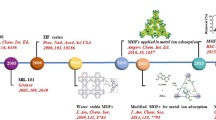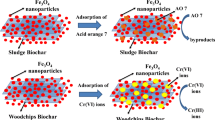Abstract
Poly(acrylp-aminobenzenesulfonamideamidine-p-aminobenzenesulfonylamide) chelating fiber containing "S", "N", and "O" elements was synthesized from polyacrylonitrile fiber and p-aminobenzene sulfonamide and used to enrich and separate trace Bi(III), Hg(III), Au(III), and Pd(IV) ions from wastewater and ore sample solution. The enrichment acidity, flow rate, elution conditions, reuse, interference ions, saturated adsorption capacity, constant of adsorption rate, analytical accuracy, and actual samples on chelating fiber were investigated by means of inductively coupled plasma optical emission spectrometry (ICP-OES) with satisfactory results. Solutions of 100 ng mL−1 of Bi(III), Hg(III), Au(III), and Pd(IV) ions can be enriched quantitatively by this chelating fiber at a rate of 1.0 mL min−1 at pH 4 and desorbed quantitatively with 20 mL of 0.25 M HCl and 2% CS(NH2)2 solution at 50 °C (with recovery ≥97%). When the chelating fiber was reused for 20 times, the recoveries of the analyzed ions enriched by the fiber were still over 95% (except for Hg(III)). One thousand-fold excesses of Mn2+, Ca2+, Zn2+, Mg2+, Fe3+, Cu2+, Ni2+, Al3+, and Ba2+ ions and thousands-fold excesses of Na+ and K+ cause little interference in the pre-concentration and determination of the analyzed ions. The saturated adsorption capacity of Bi(III), Hg(III), Au(III), and Pd(IV) was 4.850×10−4, 3.235×10−4, 2.807×10−4, and 3.386×10−4 mol g−1, respectively. The constants of adsorption rate were 0.409 min−1 for Bi, 0.122 min−1 for Hg, 0.039 min−1 for Au, and 0.080 min−1 for Pd. The relative standard deviations (RSDs) for the enrichment and determination of 10 ng mL−1 Bi(III), Hg(III), Au(III), and Pd(IV) were lower than 2.3%. The results obtained for these ions in actual samples by this method were basically in agreement with the given values with average errors of less than 1.0%. FT-IR spectra shows that the existence of –SO2–Ar, –H2N–Ar, O=C–NH–, HN=C–NH–, and –HN–SO2 functional groups are verified in the chelating fiber. From the FT-IR spectroscopy, we can see that Hg(III), Au(III), and Pd(IV) are mainly combined with nitrogen and sulfur (or oxygen), and Bi(III) is mainly combined with nitrogen (or oxygen) of the groups to form a chelating complex.



Similar content being viewed by others
References
Chang XJ, Li YF, Zhan GY (1996) Talanta 43(3):407
Kazakevich YE, Goncharova NA, Strukova IM, Emets LV (1983) Zh Anal Khim 38(12):2257
Chang XJ, Su ZX, Zhan GY (1994) Analyst 119:1445
Barash AN (1994) Zh Neorg Khim 39(3):381
Chang XJ, Yang XL, Wei XJ, Wu KB (2001) Anal Chim Acta 450:231–238
Chang XJ, Yang XL, Wang BT (2001) J Appl Polym Sci 81:2656–2660
Chang XJ, Su QQ (2001) Mikrochim Acta 137:209–213
Brajter K, Slonawska K (1983) Talanta 30:7
Su ZX, Chang XJ, Zhan GY (1991) Microchem J 44:78
Chang XJ, Su ZX, Luo XY (1993) Talanta 40:527
Kumar M, Rathore DPS, Singh AK (2001) Mikrochim Acta 137:127–134
Tawari PK, Singh AK (2001) Talanta 53(4):823–833
Kumar M, Rathore DPS, Singh AK (2001) Fresenius J Anal Chem 370:377–382
Li Y, Zhang BW (1998) Exchange Enrich Ion 14(5):388
Liu GH, Dai SS (1999) Trans Yunnan Univ (Sci) 21(4):269
Zamorova IN, Prikl Z (1992) Khim (s-Peterburg) 65(5):1084
Hou XD, Li CR, Zhang HP, Su QP Anal Chem (Chinese) 22(5):532
Shi Y, Sang X, Jiang Y (1988) Org Compound spectra and chemistry determination. Publishing House of Jiangsu Science and Technology, Nanjing, pp 75–135
Dong Q (1997) IR spectral method. Publishing House of Chemical Industry, Beijing, pp 104–178
Brgkina GD, Marchak TV, Krysina LS (1980) Zh Anal Khim (Russian) 35:2294
Acknowledgments
The authors thank Miss Wang Yanyan for her help during the experiments.
Author information
Authors and Affiliations
Corresponding author
Rights and permissions
About this article
Cite this article
Chang, X., Wang, Y. & Zhao, R. Synthesis and applications of poly(acrylp-aminobenzenesulfonamideamidine-p-aminobenzenesulfonylamide) chelating fiber for pre-concentrating and separating trace Bi(III), Hg(III), Au(III) and Pd(IV) from solution samples. Anal Bioanal Chem 377, 757–762 (2003). https://doi.org/10.1007/s00216-003-2129-1
Received:
Revised:
Accepted:
Published:
Issue Date:
DOI: https://doi.org/10.1007/s00216-003-2129-1




